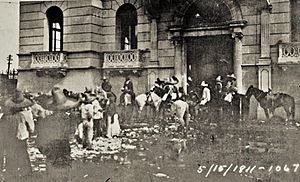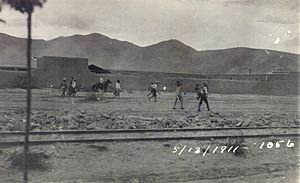Torreón massacre facts for kids
Quick facts for kids Torreón massacre |
|
|---|---|
| Part of the Mexican Revolution | |

Mexican forces outside the Casino de la Laguna
|
|
| Location | Torreón, Coahuila |
| Coordinates | 25°32′22″N 103°26′55″W / 25.53944°N 103.44861°W |
| Date | 13–15 May 1911 |
| Target | Asian Mexicans |
|
Attack type
|
Massacre |
| Deaths | 303 (see Casualties, below) |
| Assailants | |
|
Number of participants
|
4,500 |
| Motive | Ethnic hatred, Sinophobia, Anti-Japanese sentiment |
The Torreón massacre (Spanish: Matanza de chinos de Torreón) was a terrible event that happened in Torreón, Mexico, from May 13 to 15, 1911. During this time, a large group of people, including some revolutionary soldiers, attacked and killed over 300 Asian Mexicans. Most of the victims were Chinese, but some Japanese people were also killed. Many Chinese homes and shops were robbed and destroyed.
This event happened during the Mexican Revolution. Torreón was the last big city that the revolutionary forces, called the Maderistas, wanted to take over. After the government soldiers left, the rebels entered the city. Along with many local people, they started a ten-hour attack on the Chinese community. This massacre caused a serious problem between China and Mexico. China asked Mexico to pay a lot of money for the damage. An investigation later found that the massacre was an unprovoked act of racism.
Contents
Why the Massacre Happened
Chinese people started moving to Mexico as early as the 1600s. More Chinese immigrants came when Mexican president Porfirio Díaz wanted to bring in more foreign money and visitors to help Mexico's economy. In 1899, China and Mexico signed a friendship agreement. Over time, Chinese immigrants started successful businesses, especially in grocery stores. By 1910, about 13,200 Chinese people lived in Mexico.
Torreón was a popular place for immigrants around 1900. It was a key city because two major railroads crossed there. It was also near the Nazas River, which helped grow cotton. Chinese people likely started arriving in Torreón in the 1880s or 1890s. By 1900, about 500 of the city's 14,000 residents were Chinese. They were the largest group of immigrants in the city.
In 1906, a Chinese reformer named Kang Youwei visited Torreón. He bought land and later sold it to Chinese immigrants for a profit. This led to his group setting up a bank in Torreón, which helped Chinese business owners. The bank even built the city's first tram line. Soon, about 600 Chinese people lived in Torreón.
Some Mexican business owners felt worried about foreign businesses. They felt they could not compete. People in Torreón also felt angry and jealous of the Chinese community. This was because the Chinese immigrants were successful and controlled much of the grocery trade. Some people also disliked the Chinese because they were seen as cheap labor, which was part of the government's economic plan. So, opposing the Chinese was also a way to oppose the government.
Anti-Chinese feelings became clear during the Independence Day celebrations on September 16, 1910. After that, several Chinese businesses were damaged.
What Happened
Before the Massacre
On May 5, 1911 (Cinco de Mayo), a revolutionary leader named Jesús C. Flores gave a speech. He claimed that Chinese people were taking jobs from Mexican women. He also said they controlled the gardening and grocery businesses and were sending too much money back to China. He even said they were "vying for the affection and companionship of local women." He demanded that all Chinese people be forced to leave Mexico. One person remembered him saying it was a "patriotic duty" to get rid of them.
The Chinese community leaders in Torreón heard about Flores's speech. On May 12, the head of their society, Woo Lam Po, sent a warning letter. He told the community that violence might happen. He advised everyone to close their shops and hide if crowds gathered. He also said not to fight back if their stores were broken into, to stay safe.
The Attack on Torreón
On the morning of Saturday, May 13, revolutionary forces attacked Torreón. These forces were led by Emilio Madero, the brother of Francisco I. Madero. Torreón was important because of its railroads, and it was the last major city the rebels wanted to capture. Madero and about 4,500 Maderistas surrounded the city. They attacked the Chinese gardens outside the city, killing 112 people working there. Chinese homes were used by the rebels for protection, and the people living there were forced to cook for them.
The fighting continued until Sunday evening. The government soldiers, called Federales, ran out of supplies. Their leader ordered them to leave the city quietly during a heavy rainstorm early on Monday, May 15. Before the rebels entered the city, witnesses said that speeches were made to make the crowd angry at foreigners. Jesús Flores was there, calling the Chinese "dangerous competitors" and saying they should be "exterminated."
The Massacre Begins
The rebel forces entered the city at six in the morning. A large crowd of over 4,000 people from nearby towns joined them. They also joined with people from Torreón and started robbing the city's business area. The crowd let prisoners out of jail, looted stores, and attacked people on the streets.
Soon, they moved to the Chinese area. Men on horses forced Chinese people from the gardens back into town. They were dragged and those who fell were shot or trampled. Men, women, and children were killed without mercy. Their bodies were then robbed. The angry crowd finally reached the Chinese bank, where they killed the workers.
Some local people tried to help the Chinese. A tailor saved 70 immigrants by standing on a roof and sending the mob in the wrong direction. A woman named Hermina Almaráz saved 11 people. She told soldiers who wanted to take them from her home that they would have to kill her first. Another tailor saved eight people by standing in front of a laundry and lying to the rebels about people hiding inside.
Ten hours after the massacre began, around four in the afternoon, Emilio Madero arrived. He announced that anyone who killed a Chinese person would be put to death. This order finally stopped the massacre.
After the Massacre
Madero gathered the Chinese survivors in a building and placed soldiers to protect them. The bodies of the Mexican victims were buried in the city's cemetery. However, the Chinese victims were buried together in a large trench.
On the same day, Madero held a military meeting to hear about the killings. They decided that the Maderistas had done "terrible things." But the soldiers said they were defending themselves because the Chinese had been armed.
The United States Consulate and a local relief group started collecting money to help the Chinese survivors. They collected over $6,000 and gave out $30 a day to provide food and shelter.
What Happened Next
After the Massacre
After the massacre, many Chinese people left Torreón. A newspaper in Mexico City reported that over 1,000 people were leaving. Chinese people started arriving in Guadalajara, hoping to go back to China.
Stolen goods from Torreón were still being sold illegally in San Pedro for several months after the massacre.
People Lost
In total, 308 Asian people were killed in the massacre. This included 303 Chinese and 5 Japanese people. The Japanese were killed because they looked similar to the Chinese. It is thought that almost half of the Chinese population in Torreón died.
Many businesses lost most of their workers. For example, Sam Wah lost 50 employees from his farm and restaurant. Wong Foon Chuck lost 45 employees from his farm, a hotel, and his laundry. Ma Due lost 38 out of 40 workers from his gardens. Also, 25 bank employees were killed.
Other people were also killed, including 25 government soldiers, 34 bystanders (including 12 Spanish people and one German), and 26 Maderista rebels. Jesús Flores, who made the angry speeches, was also killed.
Damage to Property
The total damage from the massacre was estimated to be around US$1,000,000. Chinese properties alone suffered about US$849,928.69 in damage. Many businesses were destroyed, including the Chinese bank, the Chinese Club, 40 grocery stores, 5 restaurants, 4 laundries, and many food stands. Almost 100 Chinese homes and businesses were completely destroyed. Many Chinese-owned gardens outside the city were also ruined.
Other properties were also damaged, including a casino, the city courthouse, the jail, and police headquarters.
More Violence
The Torreón massacre was not the only time Chinese people faced violence during the Mexican Revolution. In the first year alone, about 324 Chinese people were killed by rebels and other Mexican citizens. By 1919, more Chinese people were killed in Mexico City and Piedras Negras. The attacks and unfair treatment against Chinese people in Mexico continued. It ended in 1931 when the remaining Chinese people were forced to leave Sonora.
See also
 In Spanish: Matanza de chinos de Torreón para niños
In Spanish: Matanza de chinos de Torreón para niños


